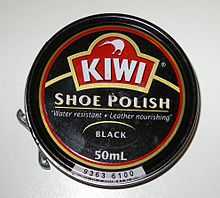Kiwi (shoe polish)
.jpg)
Kiwi is the brand name of a shoe polish, first launched and sold in Australia[1] in 1906 and as of 2005 sold in almost 180 countries. Previously owned by the Sara Lee Corporation since 1984, it was sold in 2011 to S. C. Johnson. It is the dominant shoe polish in some countries, including the United Kingdom and the United States, where it has about two-thirds of the market.
The polish was developed in Australia by William Ramsay who named it Kiwi after the flightless bird endemic to New Zealand, the home country of his wife, Annie Elizabeth Meek Ramsay. Its success in Australia expanded overseas when it was adopted by both the British and American armies in World War I.
Development
While a number of older leather preserving products existed (including the Irish brand Punch, which was first made in 1851, and the German brand, Erdal, which went on sale in 1901), Kiwi's invention in 1906 made it the first shoe polish to resemble the modern varieties (aimed primarily at inducing shine). Ramsay and fellow Scottish expatriate Hamilton McKellan began making boot polish in a small factory in 1904 in Melbourne, Australia. They developed and improved their new formula and Ramsay launched the product in 1906 and began marketing it in Melbourne. Ramsay loaded boxes of the polish on his horse and cart, and sold it to farmers to protect their boots.
Kiwi was a major improvement on previous brands. It preserved shoe leather, made it shine, and restored colour. By the time Kiwi Dark Tan was released in 1908, it incorporated agents that added suppleness and water resistance. Australian-made boot polish was then considered the world's best. A range of colours became available, and exports to Britain, continental Europe, and New Zealand began.
A rival brand of the time was Cobra Boot Polish, based in Sydney. Cobra was noted for a series of cartoon advertisements in The Sydney Bulletin, starting in 1909, using a character called "Chunder Loo of Akim Foo." (The word chunder, meaning "to vomit", possibly originated through the rhyming slang of Chunder Loo and spew.)
New Zealand is the only nation whose colloquial identity has been assisted by a brand of shoe polish . In the early years of the European settlement a variety of symbols — predominantly the moa, silver fern, Southern Cross and kiwi — were used to represent the new nation, and even by the early 1900s there was no clear consensus. The spread of Kiwi shoe polish around the world enhanced the popular appeal of the Kiwi as New Zealand's national symbol.[2]
Corporate history

Over the years, Kiwi has been owned by a variety of corporations. For the first six decades of its existence, it was part of iterations of an Australian corporation with Kiwi in its name, all based in the state of Victoria, including Kiwi Boot Polish Co. (1913–1916) and Kiwi Polish Co. (1916–1971). The company then joined with Nicholas International Ltd, a Melbourne based pharmaceutical company producing international brands such as Aspro and Rennie. The new company was renamed Nicholas Kiwi. In 1984 it was acquired by American-based Sara Lee (at the time known as Consolidated Foods Corporation) who eventually sold off the Nicholas pharmaceutical products to Roche of Switzerland and kept the Kiwi range.
Kiwi was acquired by the American company Sara Lee following its purchase of Reckitt & Colman in 1991 and Knomark in 1987. The Federal Trade Commission ruled that Sara Lee had to divest its ownership of these companies in 1994 to prevent it from becoming a monopoly. Since this ruling, Sara Lee has been prevented from acquiring any further assets or firms associated with chemical shoe care products in the United States without prior commission approval. The Competition Commission in the United Kingdom also investigated the potential monopoly of Sara Lee in the shoe care industry. On April 4, 2011, Sara Lee announced that it had completed its sale of its global shoe care business, in a majority of countries, to SC Johnson.
Kiwi remains the predominant shoe polish brand in most of the world, being sold in over 180 countries and holding a 53% market share worldwide. "World War I led to an enormous demand for 'Kiwi' polish for use by Australian, British and, later, American forces" [3] Today, it is manufactured in Australia, Canada, Honduras, France, India, Indonesia, Pakistan, Peru, South Africa, Spain, the United Kingdom, and the United States. Other leading brands include Shinola, Lincoln Shoe Polish, Meltonian, and Cherry Blossom.
References
- ↑ http://www.blancoandbull.com/boot-cleaning/kiwi-brand/. Missing or empty
|title=(help) - ↑ Phillips, Jock. "Kiwi - Kiwi and people: early history". Retrieved 26 September 2013.
- ↑ . Australian Dictionary of Biography http://adb.anu.edu.au/biography/ramsay-william-8152. Missing or empty
|title=(help)
- ^ Information on the burial place of William Ramsay
- ^ Australian Government article on Kiwi shoe polish - PDF file, taken from Imagination - 100 Years of Bright Ideas in Australia Available in print form - (ISBN 1740661060).
- ^ KiwiPhile - how Kiwi shoe polish helped choose a national symbol
- ^ Take Our Word For It
- ^ Competition Commission - Introduction to a report on Sara Lee (owners of Kiwi shoe polish) and the shoe polish market in general.
- ^ Competition Commission - Conclusions of a report on Sara Lee (owners of Kiwi shoe polish) and the shoe polish market in general.
- ^ Federal Trade Commission on Sara Lee's potential monopoly
- ^
External links
| Wikimedia Commons has media related to Kiwi. |
| ||||||||||||||||